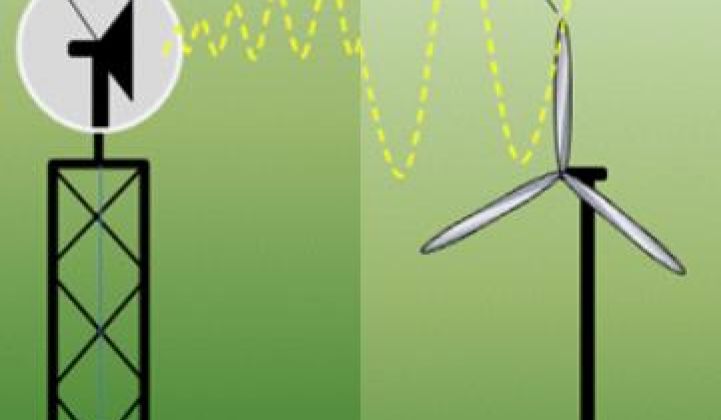Radio frequency energy emitted by radar is picked up by spinning turbine blades and, due to a Doppler effect, comes back at the radar looking like a moving target.
Because of radar interference, the British Wind Energy Association (BWEA) estimated that 4.7 gigawatts are on hold there. The American Wind Energy Association (AWEA) estimated that in the U.S., over 9 gigawatts are on hold
For both airport builders and wind developers, said Paul Palagyi, an Engineering Programs Senior Manager for Raytheon Network Centric Systems, “what you’re chasing is the wind.” The best sites for both facilities are on terrain near urban areas that are usually hungry for new air service and emissions-free electricity.
The two therefore often compete, said Brian Smith, General Manager for Raytheon Canada, “for the same wind space.”
Raytheon, at the cutting edge of the issue, just won a $22 million contract from the U.S. Department of Homeland Security (DHS) to create a tool that can identify how proposed wind farms would interact with existing radar installations.
“Any radar system, whether it’s an ATC, air traffic control radar, or radar that may be used for some other purpose, will have the potential of being interfered with,” Palagyi said. “There could be a negative interplay between a wind farm and any kind of radar.”
This explains why it is a security (DHS) matter and not a Federal Aviation Administration (FAA) matter. “The Department of Homeland Security is responsible for the U.S. border,” Palagyi said. “One of their responsibilities is for air space surveillance, which is different than air traffic control” and the FAA’s air safety responsibilities. For DHS and the border patrol, Palagyi added, “there are 'friendlies' and there is the potential for 'unfriendlies,'” which keeps them on the lookout “for aircraft or objects that are threatening.”
Smith has been developing an add-on to existing radar systems to resolve existing wind farms’ interference. Trials were completed during Summer 2010 in the U.K. and the Netherlands. “Because they’re getting so much interference, because they’re getting so many false targets from those farms,” Smith said, “they will just blank out that zone,” adding: “If you were to fly through that area, you wouldn’t be picked up by radar at all.” This creates “blind zones” -- which is not a secure or appealing solution to DHS.
The X-Band Phased Array technology Smith field-tested is designed to refine radar capabilities with a minor hardware add-on and software that uses more data to make “some changes in tracking algorithms and methods for being able to discriminate wind farms” and tell them apart from other facilities or entities, Smith explained. “We were able, in those trials, to improve the probability of detecting the wind farms from well below 70 percent” to “within normal means of 90 percent.”
The technology changes “the way radar works from the inside out,” Smith said, adding that his ultimate goal “is to make the wind farms disappear right off the screens.”
It is too early in the development process to estimate a price, Smith said. But, as opposed to building a whole new Raytheon or Lockheed Martin radar system, Palagyi pointed out, Smith’s technology is “far more cost-effective -- instead of having to use a Ferrari, you can do it with a Chevrolet.”
But Smith’s technology doesn’t help wind developers predict whether the sites they choose will get permitted or create a security threat.
“What DHS asked for in their Request for Proposal,” said Palagyi, was “a tool that would pull in where the radars are located and how they interact with any proposed wind farm.”
Such a tool would provide benefits to the government and wind developers. “It gives the government what they call unimpeachable impact assessment,” Palagyi explained. “There’s empirical data that will give credence as to whether they approve a wind farm as proposed, amend it or just flat turn it down.”
Developers will be able to determine “whether their farm will have a high probability of being approved as it is configured” or whether they will need to “move the pieces around, increase the size of it, spread it out geographically, change the mix of turbines and try to mitigate the interplay it will have with radars.”
Defining where a wind farm cannot go is “the worst outcome” the tool would provide, Palagyi said. “The best outcome would give the wind farm developer and the licensing agency enough empirical data to work with”; that way, “the interference to the radar systems could be mitigated” so the wind project and air traffic can co-exist.
The tool “is to allow DHS to make a determination,” Palagyi said, “based on fact and not supposition.” It “is going to be able to geospherically locate the wind farm” as well as “pull in from various databases where all the radars are” that would interact with it.
Raytheon will also develop an understanding of turbine operations and how radio frequencies propagate “against the environment those wind mills are in.” The tool will use simulations “to give a predictive indicator” of the wind farm’s interactions with Department of Defense “command and control systems” and, where possible, how detrimental interactions can be mitigated by developers.
The hope, Palagyi said, “is that every time they either approve of disapprove of a license for a wind farm, it doesn’t turn into a political hot potato.”



